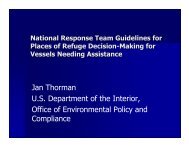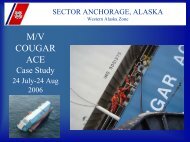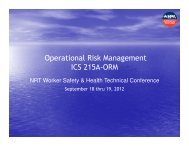NIEHS Response to the Gulf Oil Spill
NIEHS Response to the Gulf Oil Spill
NIEHS Response to the Gulf Oil Spill
Create successful ePaper yourself
Turn your PDF publications into a flip-book with our unique Google optimized e-Paper software.
<strong>NIEHS</strong> <strong>Response</strong> <strong>to</strong> <strong>the</strong> <strong>Gulf</strong> <strong>Oil</strong> <strong>Spill</strong>Joseph T. Hughes Jr., M.P.HDirec<strong>to</strong>r, Worker Education and Training ProgramNational Institute of Environmental Health SciencesNational <strong>Response</strong> TeamTechnical ConferenceOc<strong>to</strong>ber 20, 2010
<strong>NIEHS</strong> Superfund Worker Training Program<strong>NIEHS</strong> Disaster <strong>Response</strong> <strong>to</strong> <strong>the</strong> World Trade CenterImmediate and sustainedsupplemental funding <strong>to</strong>support World TradeCenter training responseefforts:– On-site training for 7,000response workers– Provision and fit-testingof respira<strong>to</strong>rs– Worker exposuremoni<strong>to</strong>ring– Responder trainingcourse– Consultation on <strong>the</strong> sitesafety plan
<strong>NIEHS</strong> Disaster <strong>Response</strong> Training Program<strong>NIEHS</strong> training activationthrough <strong>the</strong> Worker Safety & Health Annexof <strong>the</strong> National <strong>Response</strong> Framework
OSHA/<strong>NIEHS</strong>/NIOSH<strong>Oil</strong> <strong>Spill</strong> Responder Hazard Assessment TeamAdmiral Mary Landry, USCG Incident Commander meets with OSHA Assistant Secretary David Michaelsand <strong>the</strong> hazard assessment team at 6 AM on Monday, May 3, 2010 in Roberts, LA.
Extending rescue extends risk for response workersPhases of <strong>Response</strong>: Impact on SafetyRescueRecoveryClean-upChaoticRisk-takingShortFreneticPlanningNo risking livesLonger than rescuePacedNormal cleanupRisks assessed andunders<strong>to</strong>od
Incident Command System (ICS)• Used <strong>to</strong> manage emergency situationsICS uses:– Unity of command(one person in charge)– Span of control <strong>to</strong> managepersonnel (3 - 7 peopleunder one supervisor)– Life safety code– A modular system <strong>to</strong> manage resources (a system that canexpand and contract with <strong>the</strong> emergency event)– Common terms <strong>to</strong> promote seamless communication
<strong>NIEHS</strong> <strong>Response</strong> in partnershipwith OSHA and NIOSH• <strong>NIEHS</strong> developed oil spill response training <strong>to</strong>ol on April 27, 2010as <strong>the</strong> spill expands in <strong>the</strong> <strong>Gulf</strong> of Mexico.• <strong>NIEHS</strong> begins work with OSHA and NIOSH as part of <strong>the</strong> UnifiedCommand assessing worker safety issues on May 1st.• <strong>NIEHS</strong> deployed staff, subject manner experts and awardees forinstruc<strong>to</strong>r training and worker protection outreach.BP, USCG, OSHA, <strong>NIEHS</strong>, and NIOSHmeet <strong>to</strong> assess worker protection issuesin <strong>the</strong> BP Incident Command Center inHouma, LA on Tuesday, May 3, 2010.
<strong>NIEHS</strong> <strong>Oil</strong> <strong>Spill</strong> Responder Training <strong>Response</strong>• <strong>NIEHS</strong>, <strong>to</strong>ge<strong>the</strong>r with OSHA, BP and <strong>the</strong> Coast Guard, developed shorttraining courses.– Training includes: safe work practices, personal protective equipment,decontamination, heat stress, and o<strong>the</strong>r common hazards for cleanup work.– As of August 29th, per BP, approximately 150,000 people had completed<strong>the</strong>se courses.• Hazardous Waste Operations & Emergency <strong>Response</strong> (HAZWOPER)training:– 40-hour training for those who will likely have direct contact with oil spillproducts.– More than 1,000 have completed <strong>the</strong> HAZWOPER training from <strong>NIEHS</strong>grantees.
<strong>Gulf</strong> <strong>Oil</strong> <strong>Spill</strong> – vessel decontamination operations inVenice, LA
OSHA/<strong>NIEHS</strong> <strong>Oil</strong> <strong>Spill</strong> Responder Training Tool
<strong>NIEHS</strong> <strong>Oil</strong> <strong>Spill</strong> Responder Training Tool<strong>NIEHS</strong> <strong>Oil</strong> <strong>Spill</strong> Responder Training Tool:Key Health and Safety Messages
<strong>NIEHS</strong> <strong>Oil</strong> <strong>Spill</strong> Responder Training Tool
<strong>NIEHS</strong> <strong>Oil</strong> <strong>Spill</strong> Responder Training Tool
OSHA/<strong>NIEHS</strong> <strong>Oil</strong> <strong>Spill</strong> Responder Pocket GuidesOver 25,000 guides distributedFront-line responders,instruc<strong>to</strong>rs, and safety officialsEnglish, Spanish, & Vietnamese
<strong>NIEHS</strong> <strong>Oil</strong> <strong>Spill</strong> Responder Training Plan• <strong>NIEHS</strong> mission will include:– Conducting a training quality assessment process <strong>to</strong> assure thatcleanup workers receive proper training <strong>to</strong> prepare <strong>the</strong>m for oil spillresponse;– Create additional curricula and modules and provide Hazmat trainers<strong>to</strong> cover essential health and safety hazards for oil spill cleanupworkers;– Develop training <strong>to</strong> support personal protection equipment for oilspill responders;– Provide advanced Hazwoper training <strong>to</strong> subcontrac<strong>to</strong>r employees forspecialized response activities– Integrate safety and health training in<strong>to</strong> an overall responderprotection program in conjunction with BP, USCG, OSHA, NIOSH ando<strong>the</strong>rs.
<strong>NIEHS</strong>/BP Field Training for Vessels of Opportunity (VOO)workers in Venice, LA
<strong>NIEHS</strong> Mission Assignment from Unified Command<strong>NIEHS</strong> will provide support <strong>to</strong> BP and <strong>the</strong> Unified Command <strong>to</strong> support <strong>the</strong> trainingprogram for response workers participating in <strong>Gulf</strong> spill response clean-up efforts(MC252).The primary objectives are <strong>to</strong>:• Assist with <strong>the</strong> development of health and safety related course materials, trainingmatrix, and task level training requirements and PPE Assessment.• Provide quality assurance of course material and delivery of training in collaborationwith BP’s prime contrac<strong>to</strong>rs, Petroleum Education Council (PEC) Premier and TexasEngineering and Extension Service (TEEX);• Provide qualified, local trainers <strong>to</strong> <strong>the</strong> training program, managed by PEC Premier <strong>to</strong>expand and augment training resources in <strong>the</strong> impacted areas <strong>to</strong> ensure <strong>the</strong> efficientand timely promulgation of health and safety training;• Assist with <strong>the</strong> distribution of relevant safety training materials through its web siteand training distribution network within <strong>the</strong> impacted area.DELIVERABLES:• 1. Written evaluations of training delivery and content• 2. Trainers who meet qualifications defined by TEEX and live in <strong>the</strong> affected <strong>Gulf</strong>States (LS, MS, AL and FL)• 2. Delivered Training as scheduled through PEC/Premier
Dirty boom cleaning off <strong>the</strong> coast of Louisiana
Congressional Testimony June 15 th Senate & June 16th HouseHearings Regarding Human Health Effects
IOM Workshops on <strong>Oil</strong> <strong>Spill</strong> Health IssuesKey Points1. Longitudinal human health research is clearly indicated2. Health studies should begin as soon as possible2. Mental health & psychosocial impacts must not be overlooked3. Sensitive populations need <strong>to</strong> be moni<strong>to</strong>red4. External stakeholders must be part of <strong>the</strong> process5. Data and data systems should be developed <strong>to</strong> support wider research efforts
Health Research Concerns from GOS-related ExposuresMedical surveillance studies and human health exposure assessments related <strong>to</strong> <strong>the</strong>spill will be difficult due <strong>to</strong> <strong>the</strong> size of <strong>the</strong> spill area, potentially impacted shoreline area,and number of those responding or exposed.• Health Concerns– Acute• Dermal, Eye, Respira<strong>to</strong>ry• Heat-related issues & Injuries• Mental Health / Psychosocial Issues– Long-term health effects• respira<strong>to</strong>ry, neurological, carcinogenic, etc.• Target Groups• Workers• Volunteers• Exposed Community• Exposure Complexity• Chemical mixtures including raw and wea<strong>the</strong>red crude oil, dispersants, and combustion by-products.• Exposure measurements from various sources and methods
<strong>Oil</strong> <strong>Spill</strong> Responders deploy from Venice, LA
<strong>NIEHS</strong> Proposed Intramural Research“The GuLF Study”*To study potential short-and long-term healthconsequences of exposure <strong>to</strong> oil and oil byproducts• 21,000 paid community clean-up workers & volunteers exposed<strong>to</strong> burning oil, wea<strong>the</strong>red oil, dispersants, and crude oil– Currently employed and newly hired over time– Vessels of opportunity, shoreline clean-up, decontamination, anddisposal– BP oil rig workers and contrac<strong>to</strong>rsPrimary objectives• Assess potential short-and long-term health effects associated with oil spillclean-up• Create a resource for future collaborative research• Specific subgroups*Working title: <strong>Gulf</strong> Long-term Follow-up Study
<strong>Oil</strong> <strong>Spill</strong> <strong>Response</strong> Worker Safety Training Concerns• National Contingency Plan (NCP) vs. National <strong>Response</strong>Framework (NRF) – Clarifying worker safety and health protectionprocedures and pro<strong>to</strong>cols in conjunction with ICS safety officer.• All oil spill response training should grow out of <strong>the</strong> 1910.120HAZWOPER framework.• Assembly of appropriate subject matter experts for creatingtraining materials based on best professional judgments andexpertise.• Job hazard analyses (JHA’s) and exposure assessments forcreation for assuring adequacy of training components andcurricula modules.• Training assessment process for characterizing target populationsin terms of prior knowledge, literacy levels and expected job tasks.• Quality assurance process must be built-in <strong>to</strong> assure <strong>the</strong> “right <strong>to</strong>understand” and assure training responds as conditions change.
OSHA Deputy Assistant Secretary Jordan Barab in Venice,LA with his raincoat maker and HHS partners
<strong>NIEHS</strong> Superfund Worker Training ProgramIn remembrance of <strong>the</strong> eleven Deepwater Horizon drilling rigworkers who died at MC252. May <strong>the</strong>y not be forgotten.






